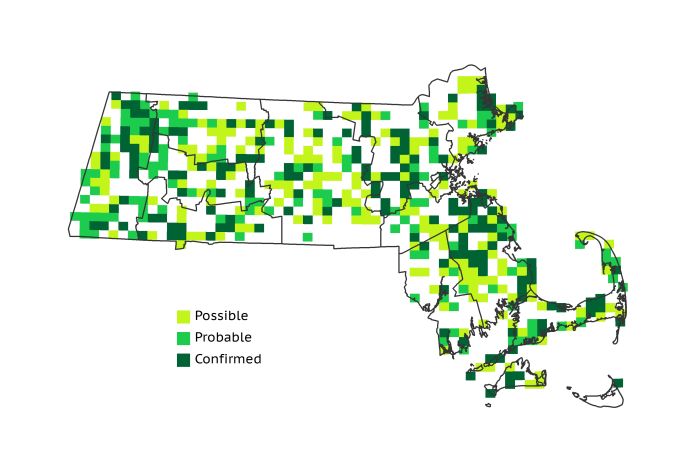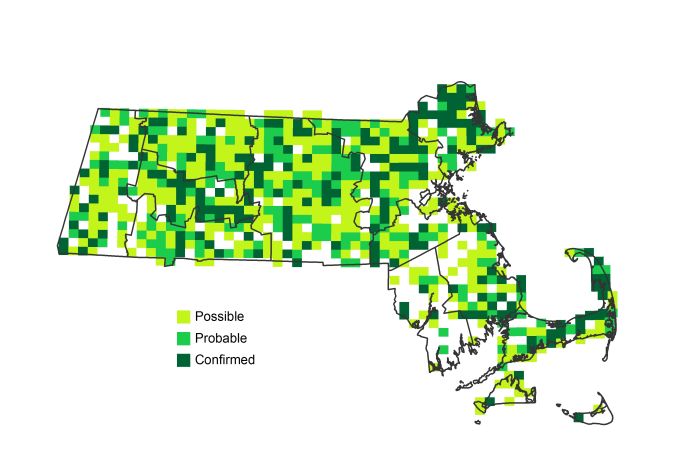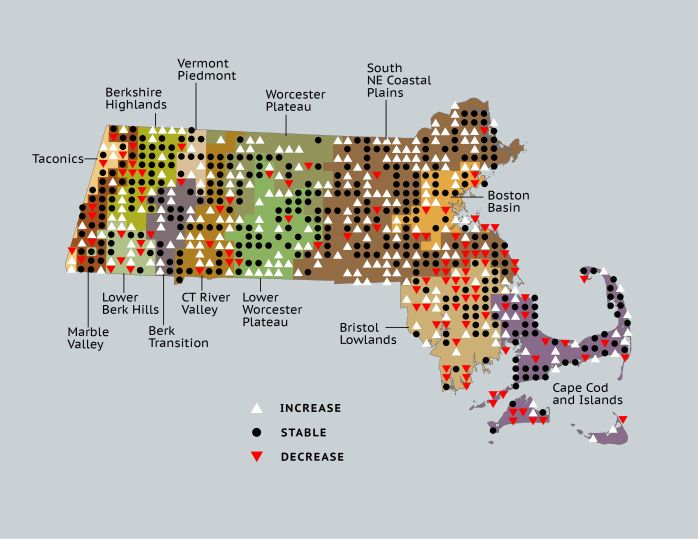Find a Bird
Belted Kingfisher
Megaceryle alcyon

Very widespread and likely increasing
“Her bill tho’ slender, sends a creaking noise, / And imitates a lamentable voice.” – Story of Ceyx and Alcyone, Ovid’s The Metamorphoses, Book XI, Garth/Dryden Translation
Belted Kingfishers periodically utter a dry, staccato rattle as they perch alongside rivers and lakes. This rattling sound will lead an attentive observer to the bird itself, an unlikely looking large-billed and ragged-crested creature that hovers and dives in calm waters in its efforts to catch fish. Kingfishers make their nests at the back of tunnels they dig into earthen banks, so they tend to be particularly common along the banks of major rivers. As it happens, mounds of earth piled high for construction purposes will suit their needs just as well, and Belted Kingfishers have likely capitalized on this increasing resource to expand their breeding footprint in recent years.
Historic Status
There is no written evidence that the distribution or habits of Belted Kingfishers across Massachusetts has changed much over time. “He may generally be seen sitting on some post or dead branch, near a solitary mill-dam, quietly watching his prey in the element below,” said William Peabody in his 1839 report to the state legislature on the birds of Massachusetts (Peabody 1839). And so it was for the ensuing century and a half.
Atlas 1 Distribution
Belted Kingfishers were widespread and fairly evenly distributed during Atlas 1. The Marble Valleys had the greatest proportion of occupied blocks (85%) by a wide margin. Throughout the western areas of the state, kingfishers were spotted during the breeding season in every region. Despite the abundance of waterways in the Connecticut River Valley, Belted Kingfishers appeared in only slightly more than half of all blocks in that region. The Worcester Plateau had kingfishers in only 40% of its blocks, though the Coastal Plains was able to boast 50% occupancy. Kingfishers had a lesser presence in the Boston Basin, but were fairly widespread throughout the Southeast, including the Cape and Islands.
Atlas 2 Distribution and Change
The Atlas 2 picture for Belted Kingfisher was encouraging, showing breeding expansion in many areas of the state. Despite this fact, a few regions that previously had hosted considerable percentages of occupied blocks seemed to be losing them by Atlas 2. Although the Marble Valleys found Belted Kingfishers in 5 new blocks during Atlas 2, the species disappeared from half a dozen, which displaced the region from its former rank as the most heavily occupied region in the state. Likewise, the Bristol/Narragansett Lowlands dipped noticeably from 50% block occupancy in Atlas 1 to 40%. Aside from these local declines, Belted Kingfishers gained an impressive amount of real estate, and looking at the most well covered blocks during Atlas 1 and 2 they newly colonized 29% of the state. The center of the state, including the Connecticut River Valley and Worcester Plateau regions, had especially notable increases.
Atlas 1 Map

Atlas 2 Map

Atlas Change Map

Ecoregion Data
Atlas 1 | Atlas 2 | Change | ||||||
Ecoregion | # Blocks | % Blocks | % of Range | # Blocks | % Blocks | % of Range | Change in # Blocks | Change in % Blocks |
Taconic Mountains | 7 | 43.8 | 1.4 | 10 | 40.0 | 1.4 | 2 | 13.3 |
Marble Valleys/Housatonic Valley | 33 | 84.6 | 6.7 | 32 | 82.1 | 4.4 | -1 | -2.6 |
Berkshire Highlands | 32 | 58.2 | 6.5 | 44 | 80.0 | 6.0 | 10 | 18.9 |
Lower Berkshire Hills | 15 | 53.6 | 3.0 | 17 | 54.8 | 2.3 | 3 | 11.1 |
Vermont Piedmont | 9 | 52.9 | 1.8 | 17 | 100.0 | 2.3 | 4 | 33.3 |
Berkshire Transition | 19 | 50.0 | 3.8 | 33 | 82.5 | 4.5 | 9 | 29.0 |
Connecticut River Valley | 31 | 55.4 | 6.3 | 53 | 81.5 | 7.3 | 12 | 25.0 |
Worcester Plateau | 31 | 39.7 | 6.3 | 80 | 90.9 | 11.0 | 19 | 39.6 |
Lower Worcester Plateau | 39 | 52.7 | 7.9 | 67 | 83.8 | 9.2 | 14 | 25.9 |
S. New England Coastal Plains and Hills | 135 | 50.0 | 27.3 | 218 | 77.0 | 29.9 | 58 | 25.7 |
Boston Basin | 21 | 37.5 | 4.3 | 31 | 55.4 | 4.2 | 10 | 18.2 |
Bristol and Narragansett Lowlands | 53 | 50.0 | 10.7 | 46 | 40.4 | 6.3 | -7 | -6.9 |
Cape Cod and Islands | 69 | 50.7 | 14.0 | 82 | 56.9 | 11.2 | 4 | 3.3 |
Statewide Total | 494 | 51.0 | 100.0 | 730 | 70.4 | 100.0 | 137 | 16.5 |
Notes
Although the Atlas shows the Belted Kingfisher’s distribution in Massachusetts expanding, the Breeding Bird Survey shows significant decreasing trends in the New England/Mid-Atlantic Region and the Eastern US overall. The Breeding Bird Survey does not show a statistically significant decline for the species in Massachusetts.



